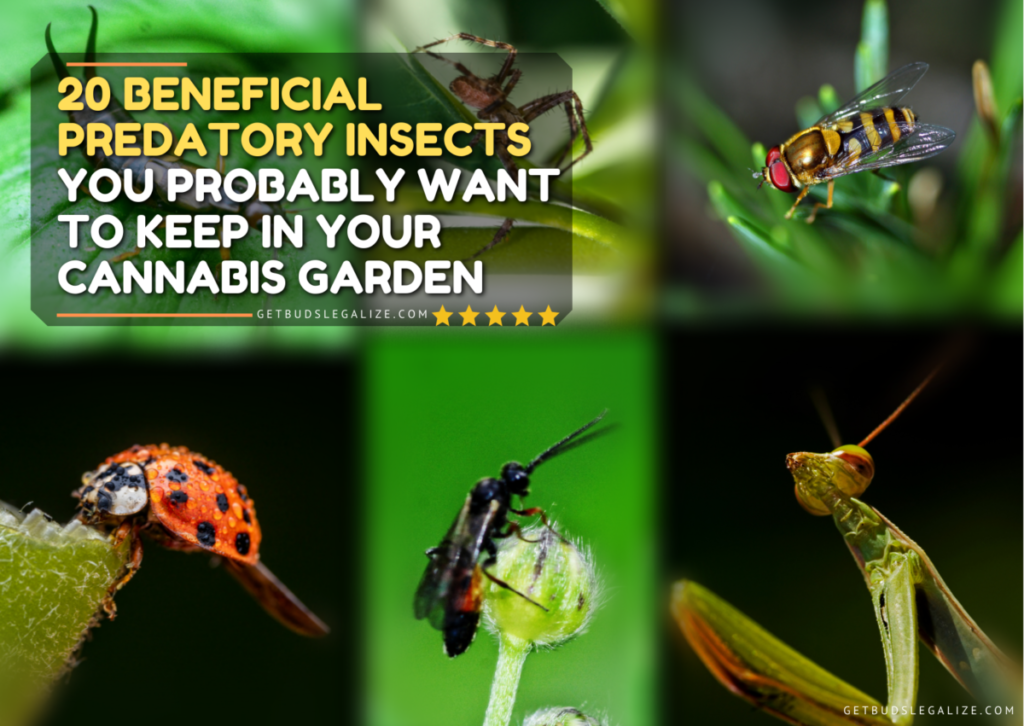20 Beneficial Predatory Insects You Probably Want to Keep in Your Cannabis Garden
Cannabis plants are susceptible to a variety of pests and diseases that can affect their growth and quality. Some of the most common enemies of cannabis plants are spider mites, aphids, thrips, whiteflies, fungus gnats, and caterpillars. These pests can cause damage to the leaves, stems, buds, and roots of the plants, reducing their yield and potency.
One way to prevent and control these pests is to use beneficial predatory insects that feed on them. Beneficial predatory insects are natural enemies of the harmful pests that attack cannabis plants. They can help reduce the population of pests and keep them in check without harming the plants and the environment.
Some of the Benefits of Using Beneficial Predatory Insects are:
- They are organic and eco-friendly. They do not leave any toxic residues or harm other beneficial organisms in the soil or the air.
- They are cost-effective and easy to use. They can be purchased online or from local nurseries and released on the plants according to the instructions provided by the supplier.
- They are adaptable and resilient. They can survive in different climates and conditions and multiply quickly to establish a stable population.
- They are selective and specific. They target only the pests that they prey on and do not affect other plants or animals.
Some of the most popular and effective beneficial bugs for cannabis plants:
1. Lady beetles (convergent Lady beetles)
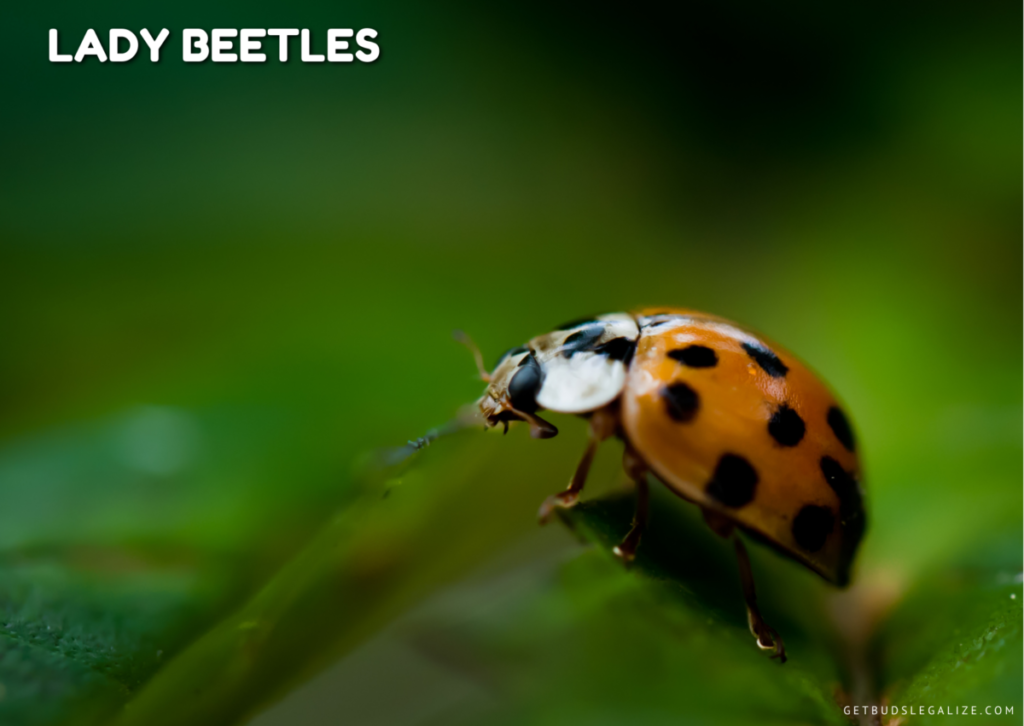
Ladybugs are one of the most beneficial predatory insects for cannabis growers. They feed on aphids, spider mites, and whiteflies that can damage your plants. Ladybugs are natural and organic, and they do not harm your cannabis or the environment.
You can attract ladybugs to your organic garden by planting flowers that they like, such as marigolds, dill, and yarrow. You can also buy ladybugs online or from local nurseries and release them in your cannabis area. Ladybugs will help you protect your cannabis from harmful insects and improve your yield and quality.
2. Green Lacewings
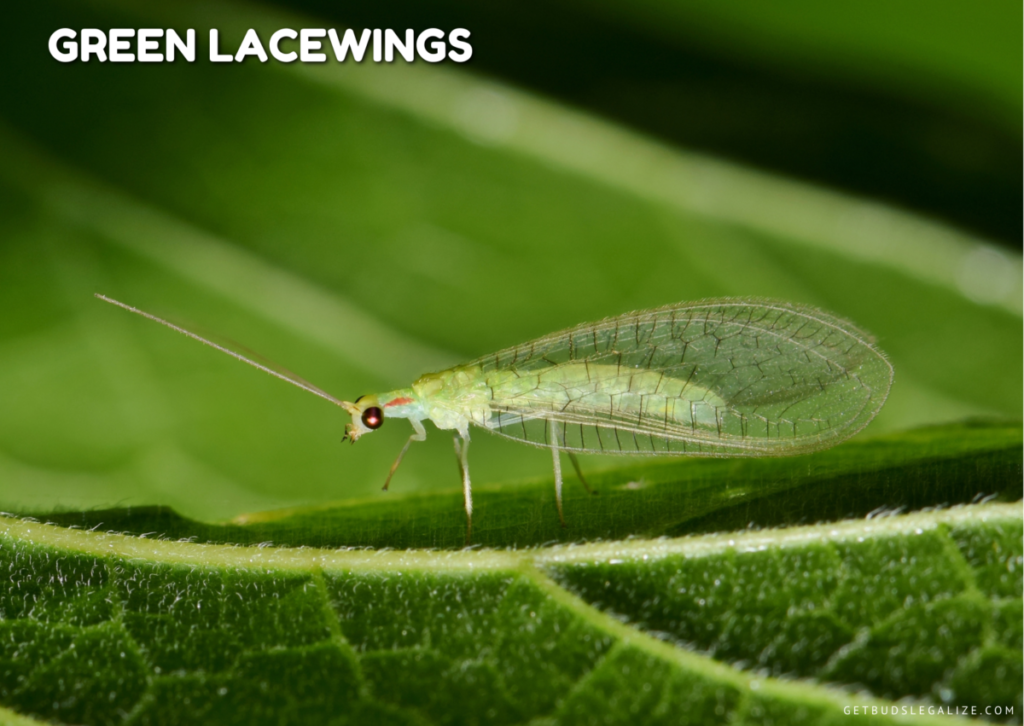
Green lacewings are beneficial predatory insects that can help protect your cannabis plants from pests. These insects feed on aphids, spider mites, thrips, whiteflies, and other harmful insects that can damage your cannabis.
Green lacewings are easy to attract or release in your garden, and they do not harm your plants or humans. They are a natural and effective way to control pests and improve the health of your cannabis.
3. Praying Mantids
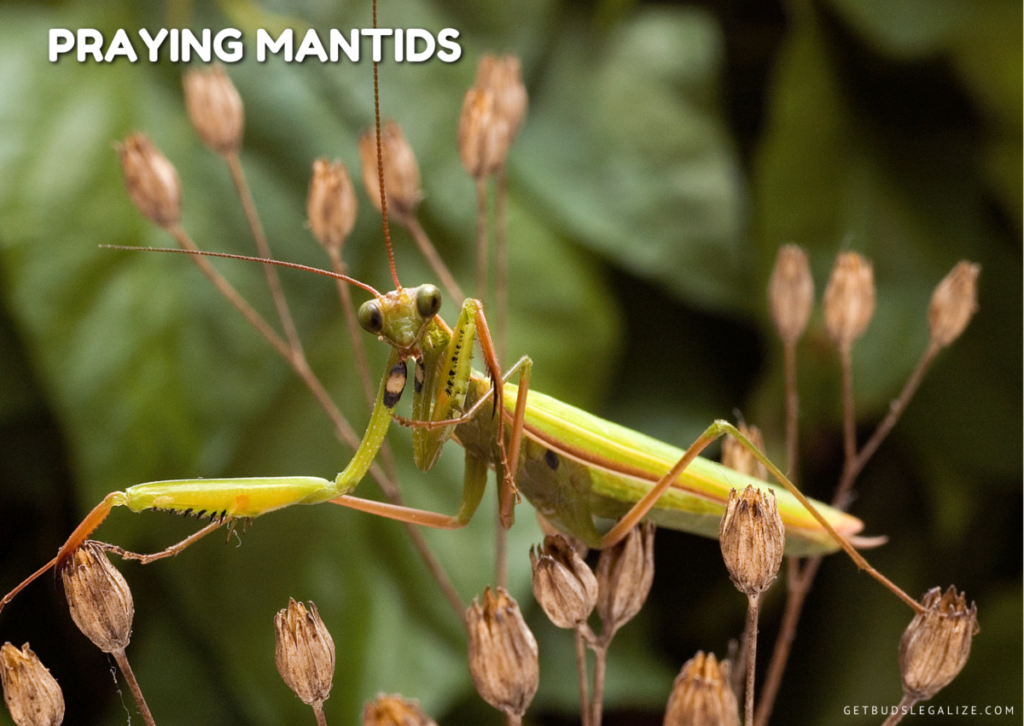
One of the most beneficial predatory insects to protect your cannabis plants from pests is the praying mantis. These insects have a voracious appetite for aphids, caterpillars, grasshoppers, and other harmful bugs that can damage your crops.
Mantises are easy to attract or introduce to your garden, as they can be purchased online or found in natural habitats. They are also harmless to humans and pets, and will not harm your cannabis plants.
Mantises are a natural and effective way to control pests and improve the health and yield of your cannabis plants.
4. Aphid Midges

Aphid midges (Aphidoletes aphidimyza) are tiny black flies that feed on aphids, one of the most common pests of cannabis plants. They lay their eggs near aphid colonies, and their larvae hatch and devour the aphids. Aphid midges are harmless to cannabis plants and humans and can help reduce the need for chemical pesticides.
You can attract them to your cannabis gardens by planting flowers that attract them, such as yarrow, dill, or fennel. Alternatively, they can be purchased from online or local suppliers and released into the garden when aphids are present.
5. Assassin bugs

One of the most beneficial predatory insects to protect your cannabis plants from pests are assassin bug. These bugs belong to the Reduviidae family and have a long, piercing mouthpart that they use to inject venom into their prey.
Assassin bugs feed on a variety of insects, such as aphids, caterpillars, leafhoppers, spider mites, and whiteflies. They are also known to attack larger insects, such as beetles and grasshoppers.
Assassin bugs are usually found on the underside of leaves or on stems, where they wait for their prey to come close. They are not harmful to humans or plants, but they can inflict a painful bite if handled.
This predator insect can be attracted to your cannabis garden by planting flowers, herbs, or shrubs that provide them with nectar and shelter.
6. Damsel bugs

Damsel bugs are beneficial predatory insects that can help protect your cannabis plants from pests. These bugs feed on aphids, caterpillars, leafhoppers, thrips, and other harmful insects that can damage your crops. They are small, slender, and brown, with long antennae and legs.
You can attract them to your garden by planting flowers such as dill, fennel, cosmos, and marigold. Damsel bugs are harmless to humans and beneficial to the environment, as they reduce the need for pesticides and increase biodiversity.
7. Earwigs
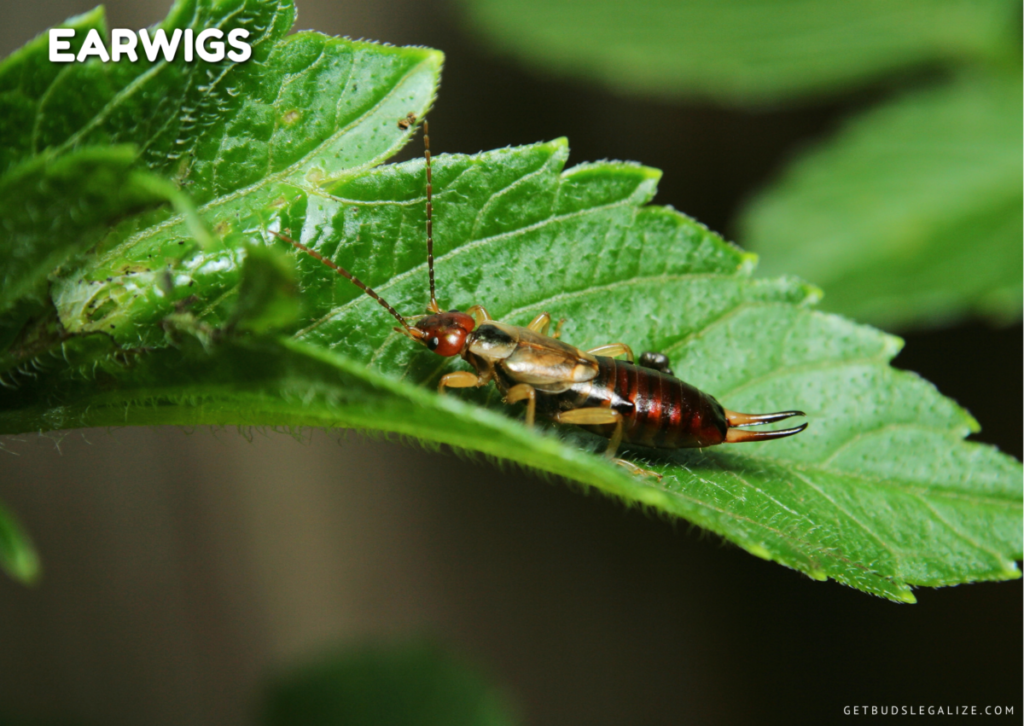
Earwigs are often considered pests, but they can also be beneficial predators that help protect your cannabis plants from other insects. They feed on aphids, mites, caterpillars, and other soft-bodied insects that can damage your cannabis leaves and buds.
Earwigs are nocturnal and hide under rocks, mulch, or plant debris during the day. To attract earwigs to your cannabis garden, you can provide them with shelter and moisture by placing damp cardboard, straw, or wood near your plants. You can also use earwig traps to monitor their population and prevent them from becoming too abundant.
8. Ichneumon wasps

Ichneumon wasps are a group of parasitic insects that can help control pests on your cannabis plants. These wasps lay their eggs inside the bodies of caterpillars, aphids, beetles, and other insects that feed on cannabis leaves and buds. The larvae then feed on the host from the inside, killing it and emerging as adult wasps.
Ichneumon wasps do not harm your cannabis plants or humans, and they can reduce the need for chemical pesticides.
You can attract them to your garden by planting flowers that provide nectar and pollen, such as dill, fennel, parsley, and yarrow.
9. Fireflies
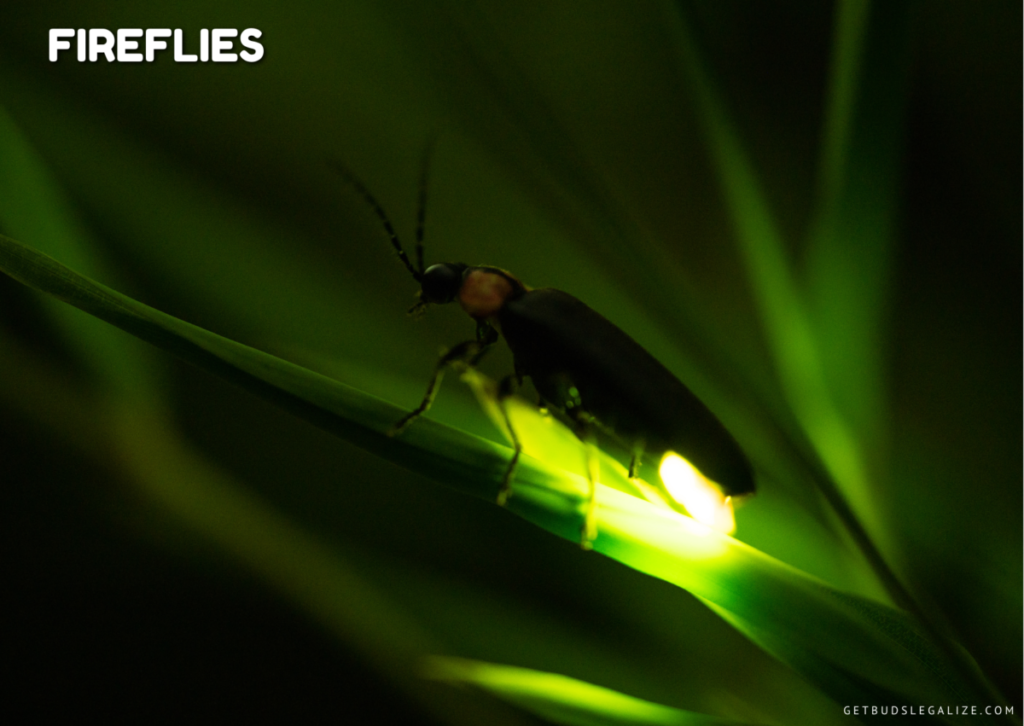
Fireflies are beneficial predatory insects that can help protect your cannabis plants from pests. They feed on soft-bodied insects such as aphids, caterpillars, slugs, and snails, which can damage your cannabis leaves and buds. Fireflies also provide natural illumination at night, which can deter nocturnal predators and thieves.
To attract them to your cannabis garden, you can plant native flowers and herbs that they like, such as dill, fennel, lavender, and mint. You can also avoid using pesticides and insecticides that can harm fireflies and other beneficial insects.
10. Soldier beetles

Soldier beetles (Cantharidae) are beneficial predatory insects that can help protect your cannabis plants from pests. They feed on aphids, caterpillars, grasshoppers, and other insects that can damage your crops.
Soldier beetles are also pollinators, which can improve the yield and quality of your buds. You can attract soldier beetles to your garden by planting flowers such as goldenrod, marigold, and yarrow.
11. Syrphid flies

Syrphid flies (also called Hover flies or flower flies) are beneficial predatory insects that can help protect your cannabis plants from aphids, thrips, and other pests. These flies have yellow and black striped abdomens and a pair of clear wings. Their larvae are small, green, and maggot-like, and they feed voraciously on soft-bodied insects.
Syrphid flies are attracted to flowers with nectar and pollen, so planting companion plants like yarrow, dill, or fennel can encourage them to visit your cannabis garden.
Syrphid flies are harmless to humans and beneficial to the environment, as they pollinate plants and reduce the need for pesticides.
12. Tachinid flies
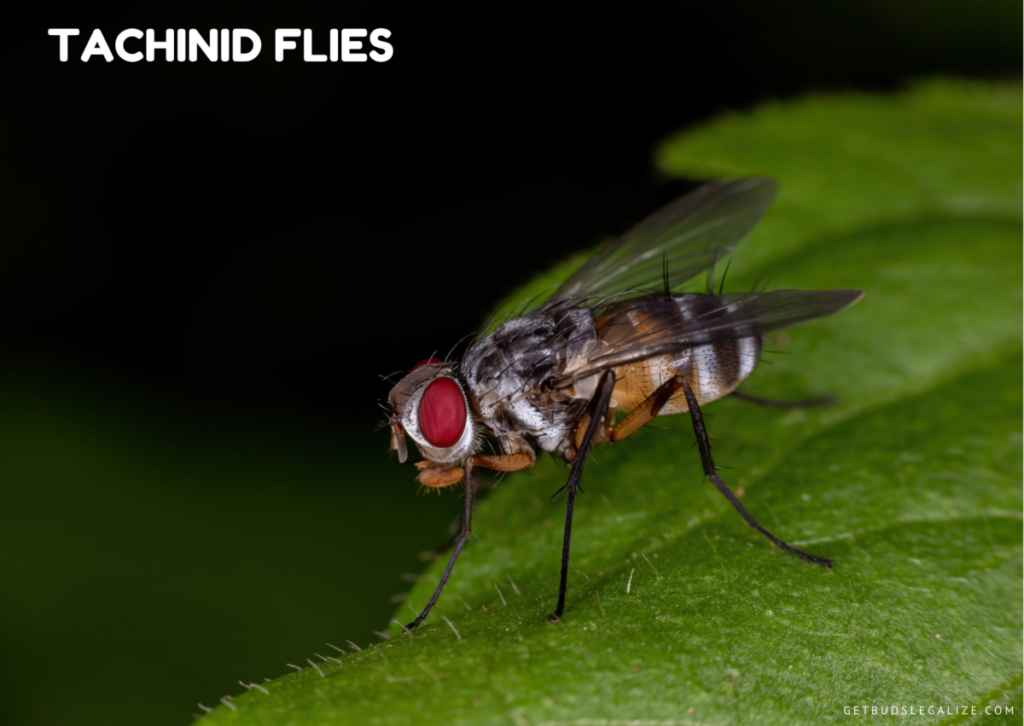
Tachinid flies (family of true flies) are beneficial predatory insects that can help protect your cannabis plants from various pests. These flies lay their eggs on or inside the bodies of caterpillars, beetles, bugs, and other insects that feed on cannabis leaves and buds. The larvae then hatch and consume their hosts from the inside, killing them in the process.
Tachinid flies can reduce the population of harmful insects and prevent them from damaging your cannabis plants.
To attract them to your garden, you can plant flowers that provide them with nectar and pollen, such as dill, fennel, parsley, and yarrow.
13. Trichogramma wasps
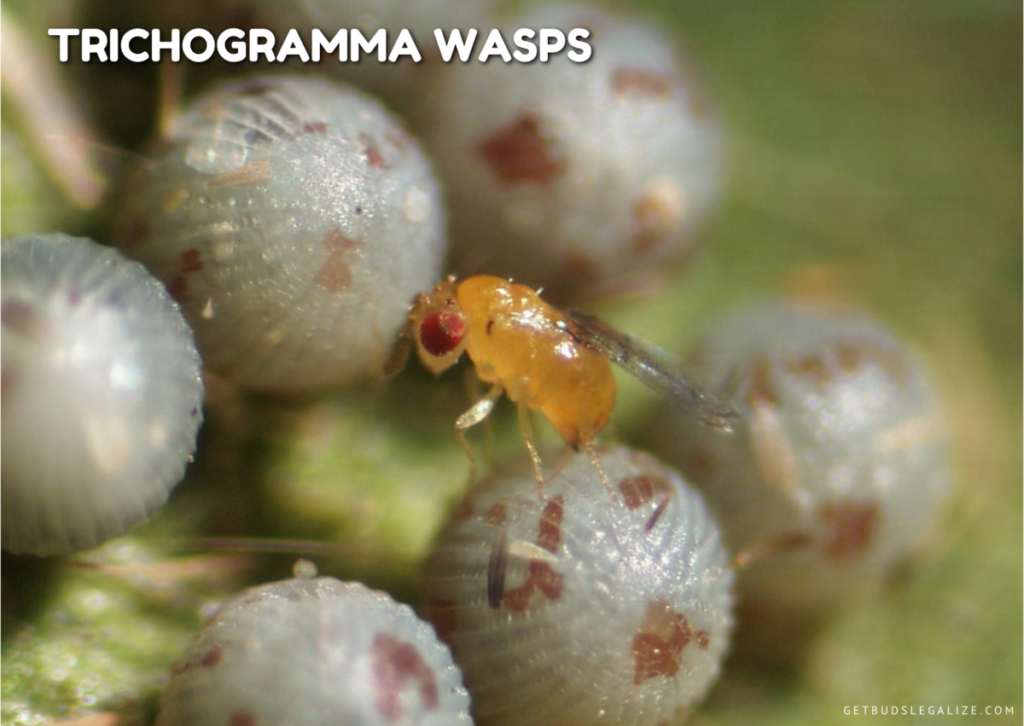
One of the beneficial predatory insects that can help protect your cannabis plants from pests is the Trichogramma wasp. These tiny wasps are parasitoids that lay their eggs inside the eggs of other insects, such as caterpillars, moths, and beetles. The wasp larvae then feed on the host eggs, preventing them from hatching and damaging your cannabis.
Trichogramma wasps are harmless to humans and plants and can be purchased online or from local garden centers. They can be released in your cannabis garden periodically to control pest populations and reduce the need for pesticides.
14. Arachnids
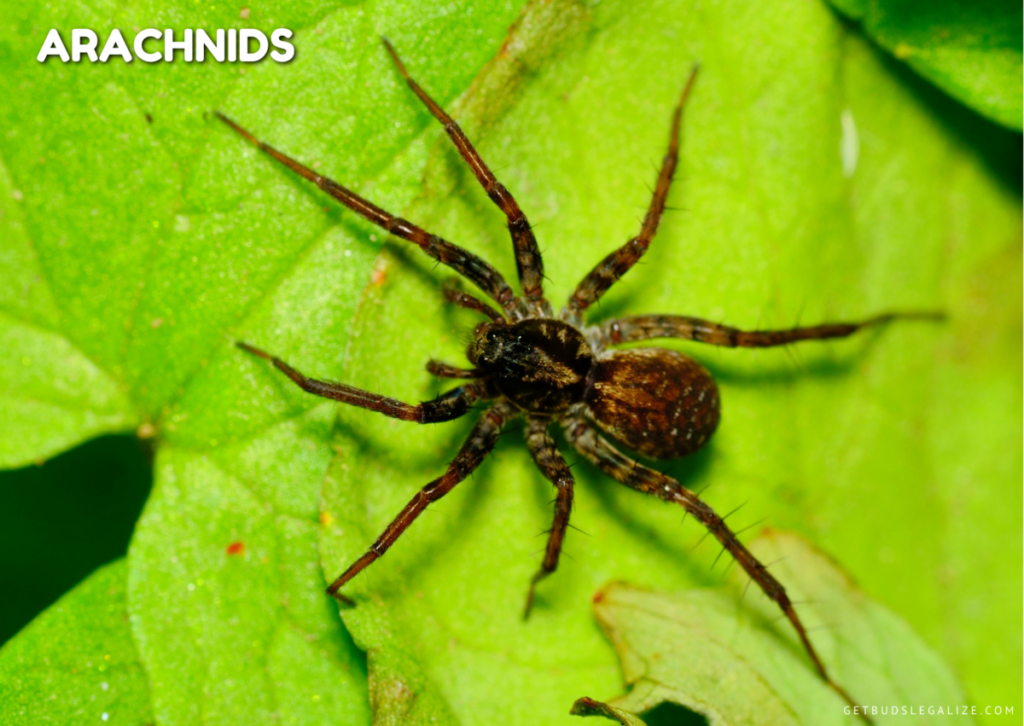
Arachnids are a group of beneficial predatory insects that can help protect your cannabis plants from pests. They feed on aphids, mites, caterpillars, and other harmful insects that can damage your crops.
Some common arachnids that you can introduce to your garden are Jumping spiders, Wolf spiders, Orb-weaver spiders, Sheet-weaver spiders, and Harvestmen.
These arachnids are natural enemies of many cannabis pests and can reduce the need for chemical pesticides. However, you should also monitor the population of arachnids and make sure they do not become too abundant or harm your plants.
15. Neoseiulus californicus
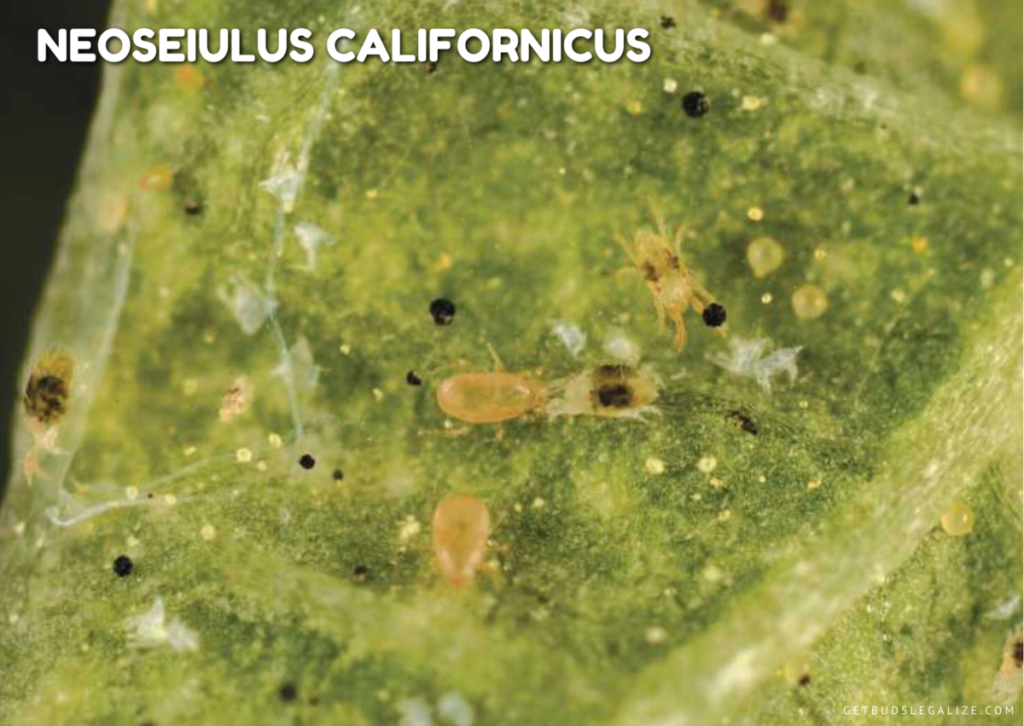
Neoseiulus californicus is a beneficial predatory insect that can help protect your cannabis plants from harmful pests. These tiny mites feed on thrips, spider mites, cyclamen mites, whiteflies, and other small insects that can damage your cannabis buds and leaves.
You can introduce them to your cannabis grow area as a preventive measure or as a biological control agent. They are compatible with most organic and conventional pesticides and fertilizers. Neoseiulus californicuscan survive in a wide range of temperatures and humidity levels, making them suitable for indoor and outdoor cultivation.
16. Orius
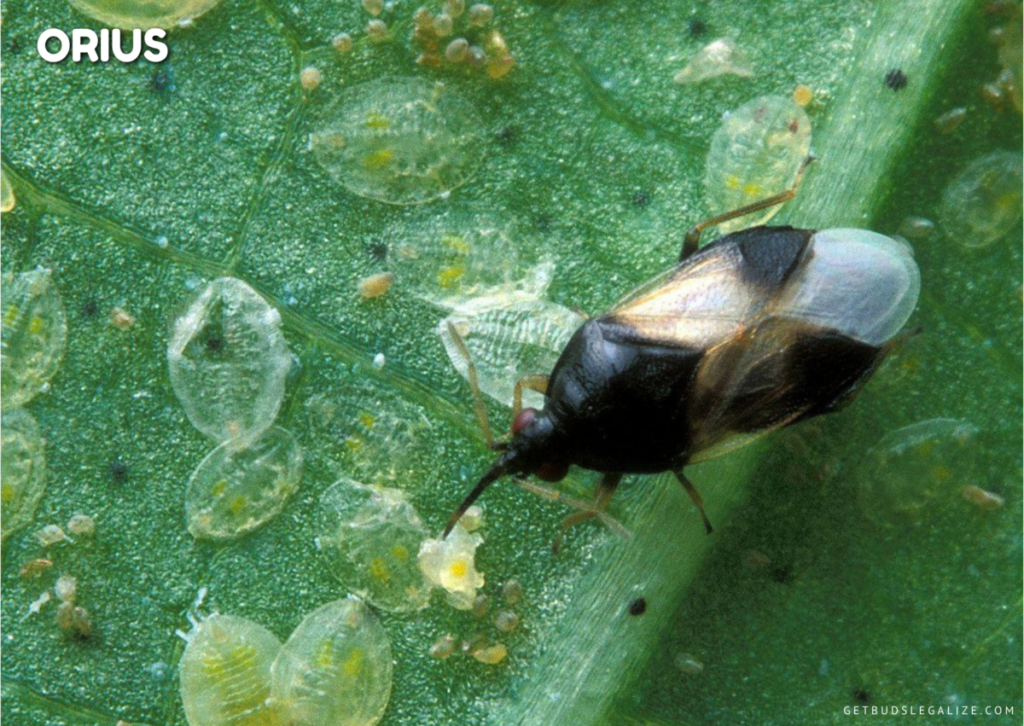
Orius, are tiny insects that feed on various pests that can damage your cannabis plants, such as thrips, mites, aphids, and whiteflies. They are especially effective against thrips, which can cause silvering and deformities on the leaves and buds.
You can purchase them from online suppliers or local garden centers and release them on your plants as soon as you notice signs of pest infestation. They can also be attracted to your garden by planting flowers that provide them with nectar and pollen, such as marigolds, cosmos, and yarrow.
Orius are harmless to humans and beneficial insects, and they can help you reduce or eliminate the need for chemical pesticides on your cannabis plants.
17. Parasitic wasps

Parasitic wasps are beneficial predatory insects that can help protect your cannabis plants from pests. These tiny wasps lay their eggs inside or on the bodies of other insects, such as caterpillars, aphids, Brown marmorated stink bugs, and whiteflies. The larvae then feed on the host insect, killing it or weakening it.
Parasitic wasps can reduce the population of harmful insects and prevent them from damaging your cannabis plants. They are also harmless to humans and plants, making them a safe and natural pest control option.
18. Spined soldier bugs
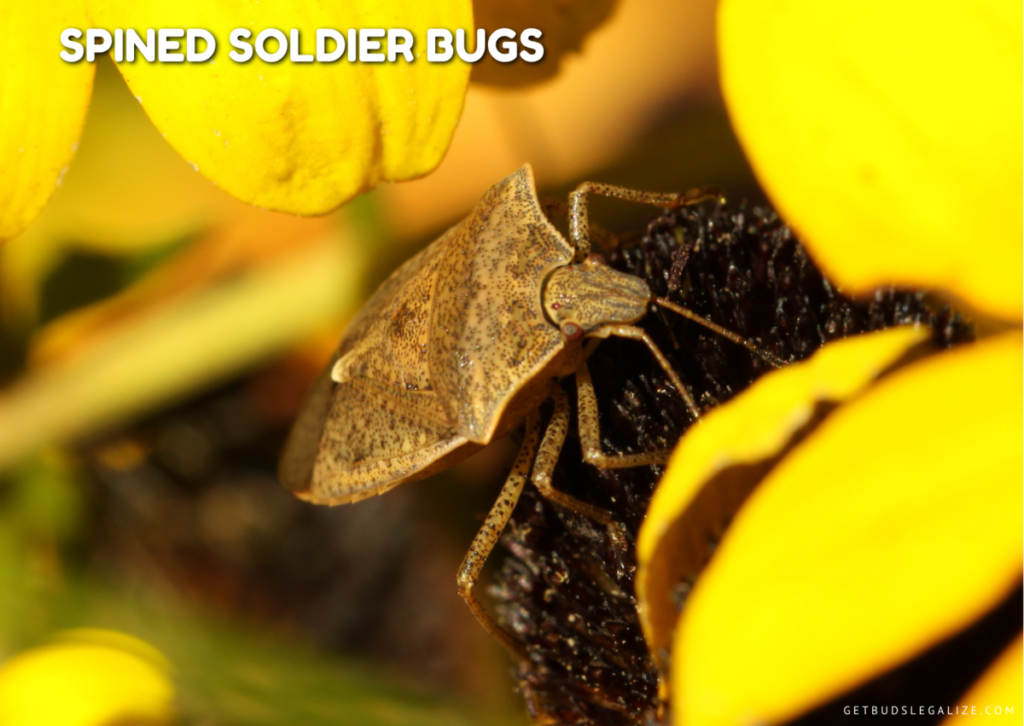
Spined soldiers are beneficial predatory insects that can help protect your cannabis plants from pests. These bugs belong to the stink bug family and have a distinctive pointed spine on their shoulders. They feed on caterpillars, beetles, aphids, and other insects that can damage your cannabis buds and leaves.
Spined soldiers are attracted to flowers, herbs, and weeds, so you can plant them near your cannabis to lure them in. You can also buy them online or from garden centers and release them on your plants.
Spined soldiers are harmless to humans and plants, but they can emit a foul odor when disturbed, so handle them with care.
19. Dragonflies
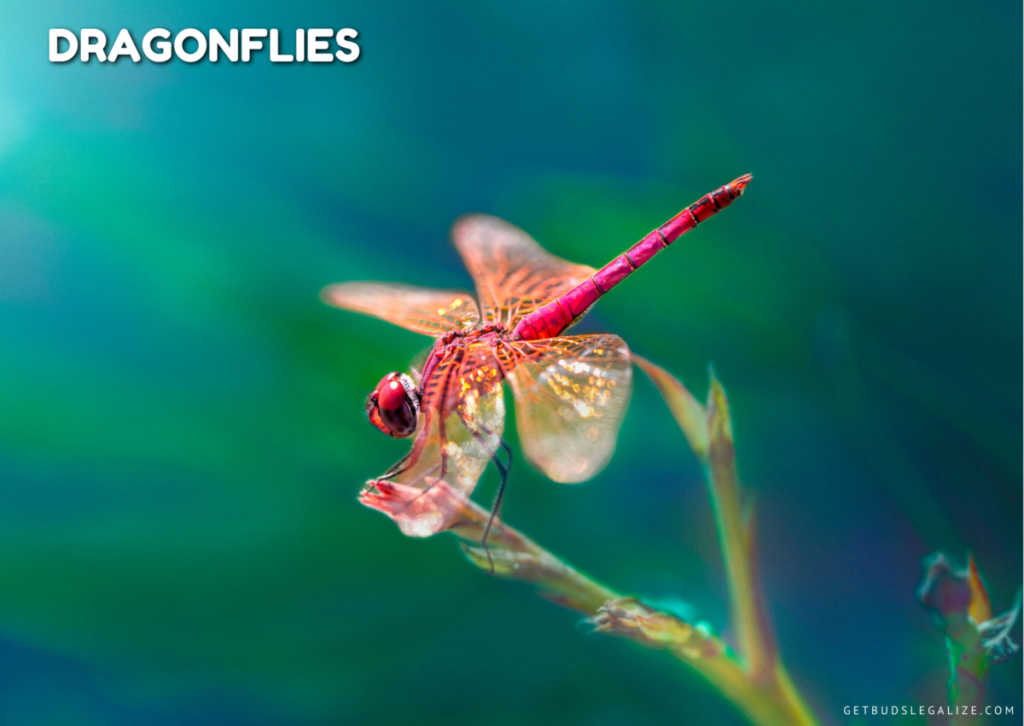
Dragonflies are beneficial predatory insects that can help protect your cannabis plants from pests. They feed on mosquitoes, gnats, aphids, whiteflies, and other small insects that can damage your cannabis leaves and buds. Dragonflies are also attractive and colorful, adding beauty to your garden.
To attract them to your cannabis plants, you need to provide them with a water source, such as a pond, a birdbath, or a fountain. Dragonflies lay their eggs in water and their larvae develop there. You also need to provide them with some plants that they can perch on and use as shelter, such as tall grasses, reeds, or bamboo. You can also buy dragonfly larvae or adults from online sources or local nurseries and release them in your garden.
Dragonflies are natural allies for your cannabis plants. They can reduce the need for pesticides and improve the health and quality of your buds. By creating a dragonfly-friendly habitat, you can enjoy the benefits of these amazing insects.
20. Phytoseiulus persimilis
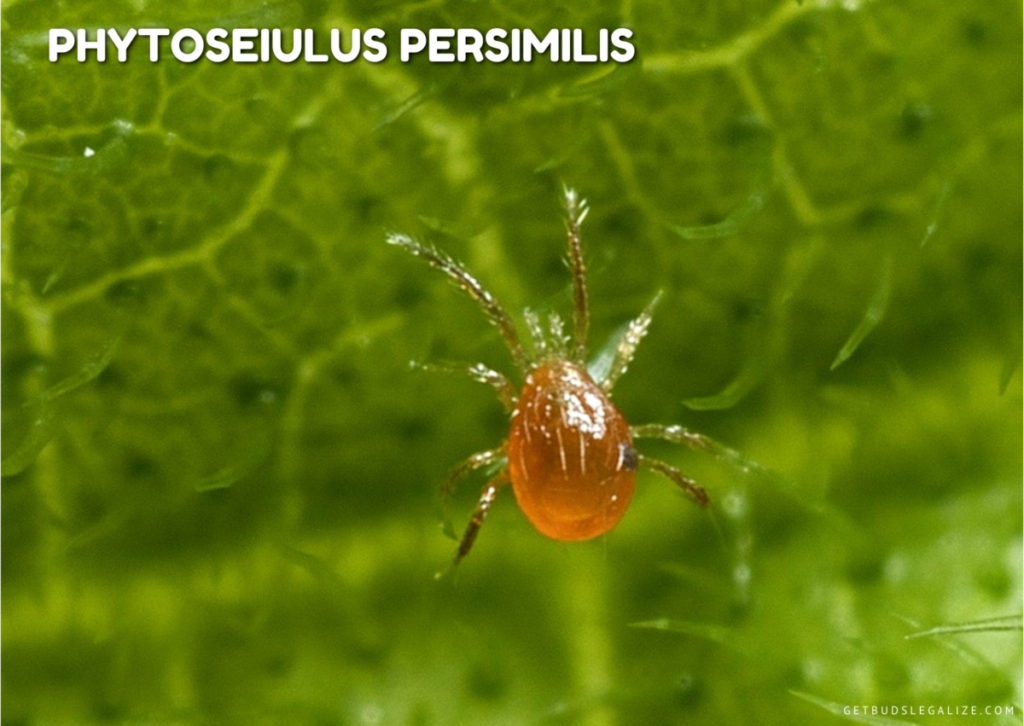
Phytoseiulus persimilis is a type of mite that can help control spider mite infestations by hunting and eating them. To use them as a biological control agent, you need to follow these steps:
- Purchase them from a reputable supplier. They usually come in small containers with some vermiculite or bran as a carrier material.
- Release them onto your cannabis plants as soon as possible after receiving them. You can sprinkle them on the leaves or use a small brush to gently transfer them.
- Provide adequate humidity and temperature to thrive. They prefer a relative humidity of 60-90% and a temperature of 20-30°C (68-86°F).
- Monitor the spider mite population and the Phytoseiulus activity regularly. You should see a reduction in spider mite numbers and webs within a few weeks. If the spider mite infestation is severe, you may need to repeat the application or combine it with other methods of pest control.
Conclusion
In conclusion, beneficial insects play a vital role in agriculture, as they provide natural pest control, pollination, and soil improvement. By attracting and conserving these insects, farmers can reduce their reliance on chemical pesticides, enhance their crop yields and quality, and promote biodiversity and ecosystem health.
Some of the strategies to support those good bugs include planting diverse crops and flowers, creating habitats and shelters, avoiding broad-spectrum insecticides, and practicing crop rotation and intercropping. By adopting these practices, farmers can benefit from the services of beneficial insects and contribute to a more sustainable and resilient agriculture.
Frequently Asked Questions
A beneficial predatory insect is an insect that feeds on other insects that are considered pests or harmful to plants, animals, or humans. Beneficial predatory insects perform a valuable service of biological control, reducing the need for chemical pesticides and enhancing the natural balance of ecosystems.
Beneficial insects are natural predators or parasites of pests that can damage cannabis plants. They can help reduce or eliminate the need for chemical pesticides, which can harm the environment and the quality of the cannabis product. Beneficial insects can also enhance the biodiversity and resilience of the cannabis ecosystem, making it more sustainable and productive.
One way to attract beneficial predatory insects is to plant a variety of flowering plants that provide nectar and pollen for them. Some examples of plants that attract predators are yarrow, dill, fennel, cilantro, marigold, sunflower, and buckwheat. These plants also provide shelter and alternative prey for predators, which helps them survive and reproduce. By creating a diverse and attractive habitat for beneficial insects, you can reduce the need for pesticides and enhance the natural balance of your garden.
Cannabis plants can benefit from the presence of certain insects that help to control pests, pollinate flowers, and enhance biodiversity. Here are some beneficial insects example for cannabis plants:
- Green lacewings: These insects feed on aphids, thrips, spider mites, and other pests that damage cannabis leaves and buds.
- Ladybugs: These colorful beetles are voracious predators of aphids, whiteflies, and other soft-bodied insects. They can eat up to 5,000 aphids in their lifetime.
- Praying-mantises: These stealthy hunters can capture and devour larger pests such as caterpillars, grasshoppers, and beetles that chew on cannabis stems and flowers.
- Predatory mites: These tiny creatures can help to control spider mites, which are one of the most common and destructive cannabis pests. They also prey on thrips, fungus gnats, and other small insects.
- Rove beetles: These soil-dwelling insects can attack fungus gnat larvae, shore flies, and thrips that live in the growing medium. They prefer moist and dark conditions.
Hover fly: These flying insects resemble bees or wasps, but they are harmless to humans. They feed on nectar and pollen from companion plants, and their larvae prey on aphids and other pests.
- Parasitic wasps: These insects are not dangerous to humans or plants, but they are deadly to many pests. They lay their eggs inside or on the bodies of their hosts, such as caterpillars, aphids, or whiteflies. The larvae then consume the hosts from within.
- Lacewings: These insects are similar to green lacewings, but they have brown wings. They also feed on aphids, thrips, spider mites, and other pests.
- Braconid wasps: These are a type of parasitic wasps that specialize in attacking caterpillars. They inject their eggs into the caterpillars’ bodies, and the larvae feed on their internal organs until they emerge as adults.
- Damsel bugs: These insects are related to assassin bugs, but they are less aggressive. They feed on aphids, leafhoppers, caterpillars, and other pests that suck or chew on cannabis plants.
These are some of the beneficial insects that can help to protect your cannabis plants from harmful pests. You can attract them to your garden by planting companion plants that provide them with food and shelter. Some examples of companion plants are marigolds, yarrow, dill, fennel, lavender, mint, basil, and clover.
Different species of predatory thrips can help control thrips populations by feeding on them. Some of the most effective predatory thrips are:
- Aeolothrips, are black with white bands and can attack various thrips species.
- Orius, are black with white spots and can feed on thrips, mites, aphids, and other pests.
- Montdorensis, is a type of predatory mite that can feed on both thrips and whitefly in protected crops.
- Hypoaspis, another type of predatory mite that can feed on thrips when they drop to the ground to pupate.
Using these natural predators for thrips control can reduce the need for chemical pesticides and enhance the health of the plants.
Several beneficial insects can help control whitefly populations by feeding on their eggs and larvae. Some of the most effective predatory insects for whiteflies are:
- Green lacewings, Chrysoperla rufilabris: These are nocturnal predators that can voraciously consume whitefly nymphs. They are sold commercially as eggs, larvae, or adults.
- Predatory mites, Amblyseius swirskii: These are tiny mites that can prey on whitefly eggs and larvae, as well as other pests such as thrips and spider mites. They are also commercially available.
- Predatory beetles, Delphastus cataliniae: These are small black beetles that can feed on large numbers of whitefly eggs and larvae. They are especially effective against silverleaf whiteflies.
- Parasitic wasps, Encarsia formosa, and Eretmocerus eremicus: These are microscopic wasps that lay their eggs inside whitefly nymphs, killing them as they develop. They are also sold commercially and can be released in greenhouses or outdoors.
- Lacewings, minute pirate bugs, big-eyed bugs, assassin bugs, ladybugs, spiders, dragonflies, and hummingbirds: These are other natural predators that can target whiteflies and reduce their numbers. They can be attracted to the garden by planting a variety of flowering plants.
Many predatory insects can help control aphids, which are sap-sucking pests that can damage plants. Some of the most effective predators are ladybugs, lacewing larvae, hoverfly larvae, and predatory midge larvae. These insects feed on aphids and other soft-bodied insects, reducing their numbers and preventing outbreaks. They can be purchased as biological controls for aphids on greenhouse plants or encouraged by providing flowering plants that attract them.
Spider mites are tiny pests that feed on plant sap and cause damage to leaves, fruits, and stems. They can be difficult to control with pesticides, as they develop resistance and hide under the webbing. A natural and effective way to get rid of spider mites is to use predatory insects that prey on them at different stages of their life cycle. Some of the most effective predatory insects for spider mites are:
- Phytoseiulus persimilis: This is a specialized predator that feeds exclusively on spider mites, especially the two-spotted spider mite. It can consume up to 20 spider mites per day and reproduce rapidly. It is best suited for warm and humid conditions.
- Neoseiulus californicus: This is a generalist predator that feeds on various types of spider mites, as well as thrips, pollen, and fungal spores. It can survive in low prey densities and tolerate high temperatures. It is best used for preventive applications.
- Green lacewings: These are voracious predators that feed on spider mites, as well as aphids, whiteflies, scale insects, and other pests. They have a long lifespan and can fly over long distances. They are best used for outdoor plants and gardens.

